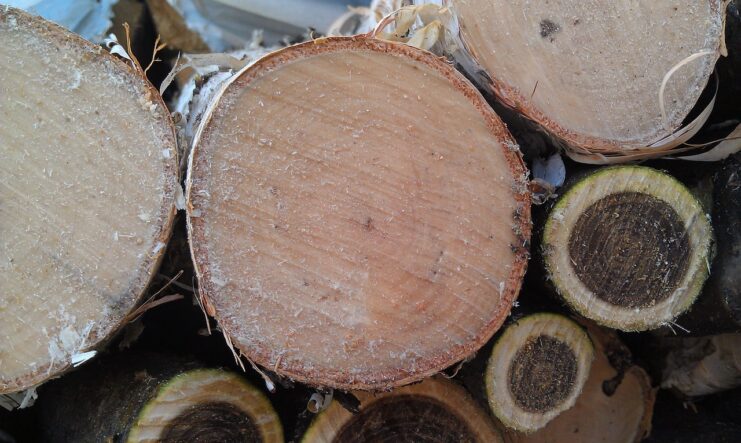The best fireplace is not just a fireplace but something that can also bring warmth, comfort, and style to your home. One of the most important aspects of a wood-burning fireplace is the logs that you burn.
Drying firewood is a necessary step in the process of turning it into a usable product for your home. Yet drying firewood on the rack can take days and sometimes weeks to complete.
If you want to skip the long process and have usable wood right away, then this Post has some great tips that will help you with seasoning firewood quickly!
Try these 7 wood drying hacks that will make your fireplace more effective and efficient!
Contents
Why is burning dry wood necessary?
There are a few reasons why it’s important to burn only dry wood.
First, dry wood burns hotter, which means you can get more heat from less wood.
Burning dry wood is necessary because it helps to prevent the build-up of creosote in your chimney. Creosote is a flammable substance that can cause chimney fires if it isn’t removed regularly.
Seasoning firewood quickly is also important because it makes the wood easier to light and keeps the fire burning for longer.
dry wood produces less smoke, so it’s better for the environment.
What is the risk of using damp wood for fires?
Wet firewood burns poorly, producing thick smoke and plenty of creosote that can and will ignite a chimney fire.
Damp wood produces less heat and creates more smoke. Smoke from damp wood can be a health hazard, as it contains harmful chemicals.
Another risk of using damp wood is that it can cause your chimney to become clogged. When wood burns, it produces a substance called creosote. Creosote is a sticky, flammable substance that can build up in your chimney and cause a fire.
So, it’s important to make sure that your wood is properly seasoned before you use it for your fires.
Drying your wood before using it is the best way to prevent these problems. Seasoning your wood properly will help you to have safer, healthier, and more enjoyable fires.
How long does it usually take for firewood to get ready to use?
Seasoning firewood typically takes between six and 12 months. How quickly firewood dries vary on a number of variables, including the quality of the wood, how it was chopped and stacked, the climate where it was stored, and the drying technique used.
It could feel like an eternity. Yet, with a few simple tricks, you may significantly cut down on the required time. By the same token, if you stick to a specific procedure, you can guarantee that it won’t take any longer than it needs to.
Firewood seasoning can be slowed down significantly if the wood is not prepared properly. Many people skip the basic steps that could have made the whole thing go more easily. As a result, there may be a long wait, which is both time-consuming and frustrating.
7 Hacks to Season Firewood Quickly:
Now let’s talk about the 7 hacks and tricks that would drastically reduce the Seasoning time of your firewood, if and only if you follow them properly:
-
Understanding the type of wood you are Working With:
It is important to pay attention to the type of wood that you use. There are some kinds of firewood that are better than others, even though you might not have a choice in the matter.
The length of time it needs to season will also depend on the type of wood you’re using. For example, softwoods like pine and others may only need six months to season correctly, whereas hardwoods like oak need at least a year.
Most softwoods will dry out much more quickly than hardwoods. They do, however, burn at a lower temperature and considerably more quickly.
In light of this, it is recommended to attempt to gather a combination of both soft and hardwoods for your wood fire. You can verify the moisture content of your logs by using a reliable moisture meter.
The quickest-drying woods are pine and willow, but you’ll need a lot of them to stay warm during a long winter.
-
Choose the Right Time of the Year to Season:
When it comes to drying your firewood, time is a crucial component. You will have your wood when you need it if you start the procedure at the proper time of year.
Some techniques considerably speed up the process, but you still need to be careful to use them at the appropriate time. The procedure needs to start in the spring. This will enable your wood to dry over the summer, which is usually the driest season of the year.
-
Splitting and Cutting the Wood:
Cut the wood into small pieces. Smaller pieces of wood will dry out faster than large logs. If you cut it properly the first time, you won’t need to redo it right before usage. To help you remember how long the wood should be when you cut it into rings, you can label the chainsaw bar.
And splitting the wood exposes more of the surface area to the air, which will help it to dry out quicker. When compared to wood that is still covered in bark, wood that has been split along the grain can dry up to 15 times more quickly. The wood will dry more quickly the more split surfaces there are.
Unsplit wood can actually continue to be green and moist for the entire summer even under ideal drying circumstances! Try to divide the wood into more manageable chunks. Aim for wood that is 10cm/4inches in diameter (across the end measurement) for the most effective burning.
-
Using an Oven:
Another way is to use an oven to help dry out the wood. You can season your firewood more quickly by using an oven to complete the task.
It can be risky to use an oven to dry your firewood, so proceed with caution and adhere to proper safety practices. You can use this strategy rather readily if you exercise a little caution.
Your oven should be set to around 300 degrees Fahrenheit. Any higher creates a fire risk, which is something you do not want. You’ll need to be careful and pay close attention to the wood. Keep in mind that the wood will emit steam as you dry it out. You must activate the fan if your oven has one.
How “unseasoned” your wood is will affect how long it needs to bake. When determining when your wood is finished, use a moisture meter.
-
Criss Cross Stack Pattern:
If you want to season your firewood quickly, try this criss-cross stack pattern. This method allows for air to circulate around the wood, which speeds up the drying process.
To do this, simply stack your firewood in a criss-cross pattern. Start by placing two pieces of wood perpendicular to each other. Then, place another piece of wood on top of those two, but at a diagonal angle. Continue this pattern until all of the wood is stacked.
Make sure that the pieces of wood are not touching each other. If they are, the air will not be able to circulate properly and the wood will not dry as quickly.
This method works best if you live in an area with a lot of sun and wind. The sun will help to dry the wood and the wind will circulate the air around it.
This method is great if you are short on time and need to get your wood dry quickly. It’s also a space-saving method if you have limited storage space. Try it out and see how it works for you!
-
Keeping Wood in Sunny and Dry Spot:
keep the wood in a sunny and dry spot. You can put it in your yard or on your porch. Make sure it is not in the shade or in an area where it will get wet.
If you can get the sun and wind to blow across your wood pile, the wood will dry up more quickly. Reducing moisture is the main goal of seasoning firewood. The better, the less moisture there is in the air.
In order to hasten the drying process, leave your freshly cut wood exposed to the wind and sun in a roughly built firewood stack for a few months.
The drying period could be extended by a year or more if firewood is stacked directly inside a closed and covered wood shed.
-
Using Dehumidifiers
If you’re in a rush and need dry firewood ASAP, you may always bring it inside and run a dehumidifier to remove some of the moisture. This will shorten the time it takes for the wood to dry out, but it works best for removing minor rain stains on otherwise well-seasoned wood.
Assemble your stack with lots of air spaces, and avoid using your dehumidifier outside or in locations where the plug could become wet. A dehumidifier will significantly dry the air.
This is a wise decision if
- You reside in a humid region.
- You want to combine it with another strategy.
- And it has been raining a lot in Your region.
The price of running a dehumidifier is something to consider. Dehumidifiers need electricity, so factor that into your budget planning.
Final Words
Seasoning firewood can be a long and tedious process, but it doesn’t have to be! By using these simple tips and tricks, you can get your firewood ready for use in no time!
Follow these instructions to make sure you have sufficient dry wood and kindling for your fire if you intend to use a wood fire or wood cook stove this winter. Unseasoned wood can produce terrible creosote buildup and provide inadequate fire heat.

